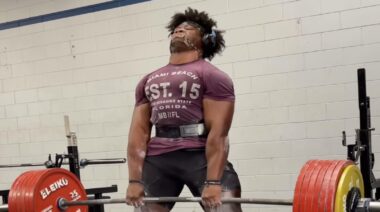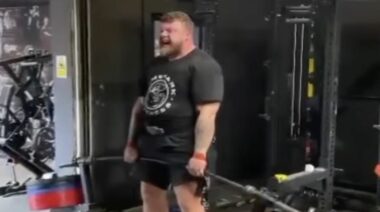“You’re going to CRIPPLE yourself!!!”
It’s annoying. For whatever reason, YouTube seems to be the worst place for receiving the most off-the-wall and harassing comments. Of course, not all of them are bad, but a significant portion is.
Here I am deadlifting over 500lbs. It’s not an elite weight by any means. But it’s not that bad either. At a bodyweight of about 190 right now it’s over a two and a half times bodyweight lift. I filmed this lift specifically from the side to see how much my back rounds.
Many people can’t even come close to lifting this weight, yet they have the audacity to critique my form. I’m sure it is well intentioned, but that doesn’t mean they know what they’re talking about. Let me ask you a question:
What Is Perfect Form?
Ask ten different people and you’ll likely get ten different answers. Some of the more typical responses are:
“It looks good even to the casual observer.” – By casual observers, that means someone with no exercise experience. Right, because that is how art and wine are judged, by people who have no reference experiences. Here is how I like to judge form – by what it allows you to accomplish in a safe manner.
“A generally accepted ideal.” – The problem with this is that every person is different. Since we have different body shapes certain people can do positions that others cannot. I can grasp the idea of an ideal, but that too needs to be individualized to the person. For competition, of course, there is the need of standards. How the exercise is done isn’t so much looked at as long as it gets to a specific place. But here there is much debate too. Different judges would call one squat deep enough and others might say its not.
“Something that doesn’t cause pain or injuries.” – I agree with pain and injuries being something to avoid. But does “perfect” form really stop injuries? I’ve seen people get hurt with perfect form before. I’ve seen plenty of people not get hurt from “bad” form too.
Going back to the fact that everyone is individual, you must recognize that what will be great for one person could immediately cause problems for another. This is why exercises are commonly adapted to suit what a person can and can’t do.
For me the rounded back deadlift works. And it works well. I can handle a good amount of weight in it. If I force my back to stay straight, I cannot lift nearly as much. I’ve also been doing it for quite some time and haven’t hurt myself doing it.
Why is this? I’m not sure. When visiting a chiropractor awhile back she commented that my lower back was straighter than most people. It didn’t have the normal curve. She thought this had to have always been that way. Maybe that is why I can safely round back deadlift. Or perhaps it’s like that from how I’ve been deadlifting.
Natural Form
If someone has never been taught how to lift before and goes to pick up something heavy, what are they going to do? Will he or she squat down low and make sure to keep the back extra straight? Or is the lift going to end up as a round back deadlift?
Once again, I’m not saying you need to throw out everything you’ve learned or that coaching is worthless. But there is something to be said for how you would naturally do something. Contrary to what some spine experts seem to say – that if your back ever rounds you’re going to immediately die of the bubonic plague – the human body can move that way. So why not train it? Why not take a position of compromise and make it stronger?
Is a Round Back a Stronger Back?
What happens when people work on a heavy weight for them? Their straight back form breaks down and they start to round their back. Are they not strong enough to maintain their form? Or is it that a rounded back position is actually stronger to be in?
Look at so many of the record setting deadlifters in the world:
Bob Peoples, who has been called “Mr. Deadlift,” decided after much work that lifting with a round back was best for him. Not only that but he exhaled his breath fully before lifting. At a bodyweight of 181lbs he lifted 725lbs. Are you going to say he was doing it wrong because his back rounded? Or are you going to look at the numbers he was able to put up by doing that?
Konstatin Konstantinov has lifted an amazing 939lbs – raw. Some might say it’s just his upper back that is rounding. To me it looks like everything is fairly rounded.
If many of the top deadlifters in the world are doing it, does that mean it can be done safely, and may even be a superior form to lift with? What do you think? Please post your thoughts to the comments.
Photo courtesy of Shutterstock.






